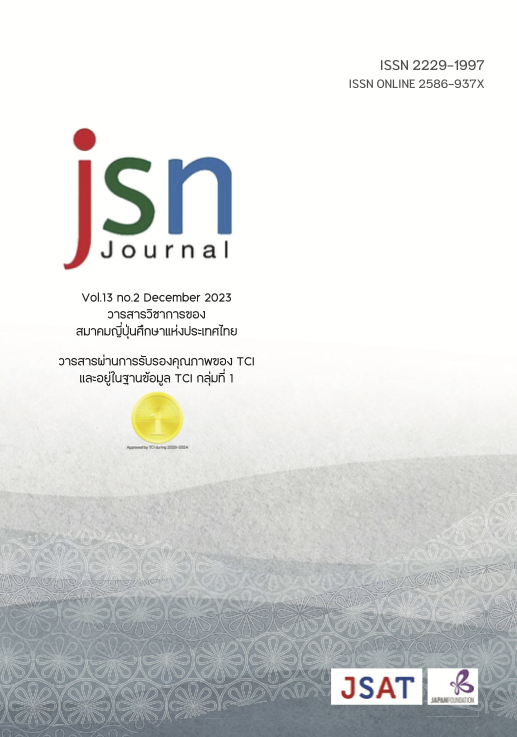Human Behaviour Change Based on Nudge Theory: An Empirical Test at an Expressway Rest Area in Japan
Main Article Content
Abstract
Nudge theory is an approach that uses behavioural science findings and theories to ‘gently push’ people into acting. This paper focuses on the possibility of using nudges to improve the satisfaction of highway rest area users. We set up a mechanism for users of highway parking rest areas to engage not only in functional behaviour but also free behaviour and to conduct a demonstration experiment based on nudge theory.
Previous studies have focused on whether or not the nudge theory approach is effective or not and have come to fairly uniform conclusions. In this study, we measured whether the effectiveness of the nudges varied according to ‘subject demographics’ and ‘location’. The data were examined using the two-way analysis of variance (ANOVA) method. Results of the experiment, we were able to detect significant differences between attributes (adults and parents with children) due to the nudge mechanism.
Article Details

This work is licensed under a Creative Commons Attribution-NonCommercial-NoDerivatives 4.0 International License.
ข้อความและข้อคิดเห็นต่างๆ ในบทความเป็นของผู้เขียนบทความนั้นๆ ไม่ใช่ความเห็นของกองบรรณาธิการหรือของวารสาร jsn Journal
References
Behaviour Institute. Learn how to change behaviour. https://www.besci.org/models/behaviour-analysis-strategy-intervention-change
Dreibelbis,R.,Kroeger, A., Hossain,K.,Venkatesh, M., & Ram,P.K. (2016).Behaviour change without behaviour change communication: Nudging handwashing among primary school students in Bangladesh. International Journal of Environmental Research and Public Health, 13(1), 2–7.
Franssens, S., Botchway, E., Swart, W., & Dewitte, S. (2021). Nudging Commuters to Increase Public Transport Use: A Field Experiment in Rotterdam. Frontiers in Psychology, Volume 12 - 2021, 1-6.
Ishikura,K.,Kato, M.,Kai,Y.,Yamaguchi, D.,Yoshiha,K., & Fukuda,Y. (2021).Randomized controlled intervention trials to promote physical activity and nudge strategies for tools used in national implementation cases - categorization of MINDSPACE elements. Japanese Society of Health Education and Promotion, 29(3), 257–262.
Mamede, A., Noordzij, G., Jongerling, J., Snijders, M., Schop-Etman, A., & Denktas, S. (2021) CombiningWeb-Based Gamifcationand Physical Nudges With an App (MoveMore) to Promote Walking Breaks and Reduce Sedentary Behavior of Office Workers: Field Study. Journal of Medical Internet Research, 1-15.
Meeusen, R., Voorn, B., & Berk, K. (2023) Nudging strategies to improve food choices of healthcare workers in the workplace cafeteria: A pragmatic field study. Clinical Nutrition ESPEN Volume 53, 126-133.
Meiden, I. (2018). Encouraging stair use among office users: The effect of nudging interventions in an office environment [Master’s thesis, Wageningen University and Research, pp. 27–30; 33–36].
Meiden, I.,Kok, H., & van derVelde, G. (2019). Nudging physical activity in offices, Journal of Facilities Management · September 2019, 320–321.
NEXCO Central JapanLimited web page,https://sapa.c-nexco.co.jp/sapa?sapainfoid=90,Reference date May 31, 2023
Perry, C., Chhatralia, K., Damesick, D., Hobden, S., & Volpe, L (2015). Behavioural insights in health care - Nudging to reduce inefficiency and waste. The Health Foundation, England. https://www.health.org.uk/sites/default/fles/BehaviouralInsightsInHealthCare.pdf
Samaranayake, D., & Thennakoon, R. (2021). Could Behavioural Nudges Improve the Accuracy of Waste Sorting? AnExperimentalSurvey.Environment and Pollution; Vol. 10, No. 1- 2021, 1-12.
Smart Insights (2023). How to apply EAST: A behavioural insights framework to improve customer experience. https://www.smartinsights.com/user-experience/customer-experience-management-cxm/use-east-behavioural-insights-framework-improve-customer-experience/
Takemoto, T., Honda, T., Kiyomitsu, S., Takayanagi, T., Tonogaki, Y., Yamada, K., Yamamoto, R.,Okamoto, H., & Oe, H. (2022). An exploratory study of the functional and intangible factors in decisions to use service areas attached to motorways, Economic Journal: Scientific Journal of Accountancy, Management and Finance 2(3), 202.
Thaler, R. H. & Sunstein, C.R. (2008). Nudge: Improving decisions about health, wealth, and happiness (pp. 25–35). Yale University Press.
Weghorst, M. H. (2016). Exploring the possibility of pro-environmental nudging by fine-tuning the stairs versus elevator nudge [Thesis, Utrecht University].
Weijers, R., Koning, B., Vermetten, Y., & Paas F. (2023) Nudging Autonomous Learning Behavior: Three Field Experiments. Education Sciences Volume 13 Issue 1, https://www.mdpi.com/2227-7102/13/1/49


